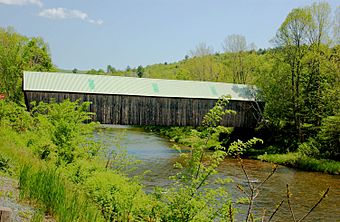Lincoln Covered Bridge facts for kids
Quick facts for kids |
|
|
Lincoln Covered Bridge
|
|
 |
|
| Nearest city | Woodstock, Vermont |
|---|---|
| Area | 1 acre (0.40 ha) |
| Built | 1877 |
| Built by | Pinney, R. W.; Pinney, B. H. |
| Architectural style | Pratt truss system |
| NRHP reference No. | 73000212 |
| Added to NRHP | August 28, 1973 |
The Lincoln Covered Bridge is a really old and special bridge in West Woodstock, Vermont. It's a "covered bridge," which means it has a roof and walls, like a long house over the water! This bridge was built way back in 1877. It's super unique because it's one of the only wooden bridges in the whole United States that uses a special design called a Pratt truss. Because it's so important, it was added to the National Register of Historic Places in 1973.
Contents
About the Lincoln Covered Bridge
The Lincoln Covered Bridge crosses the Ottauquechee River. It's located just west of West Woodstock village. The bridge connects US Route 4 to other roads on the river's south side.
Bridge Size and Design
This bridge has one main section. It is about 136 feet (41 m) long. It sits on strong concrete and stone supports. The bridge is 18.5 feet (5.6 m) wide, but the part cars drive on is 14 feet (4.3 m) wide. This means it's a one-lane bridge.
The bridge has a special design. It uses two arch trusses for support. These trusses are like giant frameworks. A wooden structure with a metal roof covers them. The sides are made of vertical wooden boards.
What is a Pratt Truss?
The Lincoln Covered Bridge uses a special kind of design called a Pratt truss. This design helps the bridge hold a lot of weight. It uses a mix of wooden and iron parts. These parts work together to support the bridge's deck. Iron cross-bracing adds extra strength.
Bridge Improvements in 1989
In 1989, the bridge got a big upgrade. The Vermont Agency of Transportation worked to make it stronger. Their goal was to make it look original. They also wanted it to safely carry emergency vehicles.
Workers focused on fixing the ends of the main supports. These parts had worn out over time. They used materials that looked like the original ones. To make the bridge stronger, they added hidden steel rods. These rods are underneath the wooden parts. This way, the bridge looks old but is very strong.
Skylights and Flood Protection
During the upgrade, skylights were added to the roof. These are made of clear plastic. They let natural light into the bridge. This makes it brighter inside.
Old steel cables were also removed. These cables used to tie the bridge to the shore. People thought this would protect it from floods. But, it often caused more damage. Now, if there's a flood, the bridge can move with the water. This helps prevent it from breaking apart. After the flood, it can be put back in place. This method saves the bridge and costs less to fix.
History of the Lincoln Bridge
The Lincoln Covered Bridge was built in 1877. Two builders, R.W. Pinney and B.H. Pinney, constructed it. They were from nearby towns.
The Pratt truss design was invented about 30 years before this bridge was built. Most bridges using this design were made of metal. The Lincoln Covered Bridge is very special. It is believed to be the only wooden bridge left in the United States that uses the Pratt truss design. This makes it a very important piece of history!

